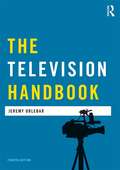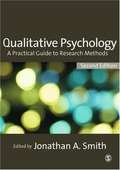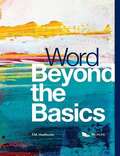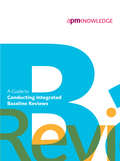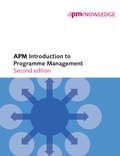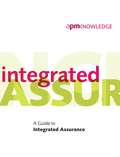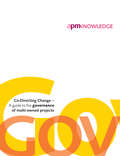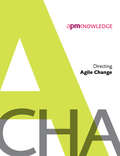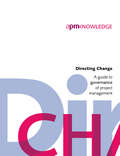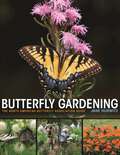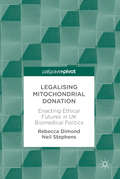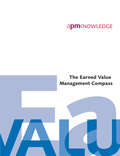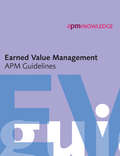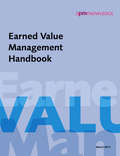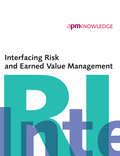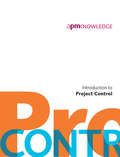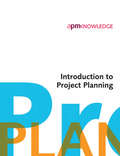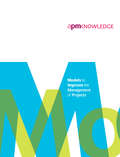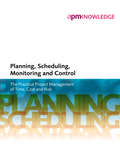- Table View
- List View
The Television Handbook (PDF)
by Jonathan BignellThe Television Handbook is a critical introduction to the practice and theory of television. The book examines the state of television today, explains how television is made and how production is organised, and discusses how critical thinking about programmes and genres can illuminate their meanings. This book also explores how developments in technology and the changing structure of the television industry will lead the medium in new directions. The Television Handbook gives practical advice on many aspects of programme making, from an initial programme idea through to shooting and the post-production process. The book includes profiles giving insight into how personnel in the television industry - from recent graduates to television executives - think about their work. The Television Handbook offers chapters on the vigorous debates about what is meant by quality television, how news and factual programmes are responding to interactive technologies, and how formats such as Reality/Talent TV have risen in prominence. It also considers how drama, sport and music television can be discussed and interpreted. The Television Handbook includes: Profiles of TV news and drama producers, editors and TV studio personnel Case histories of important TV genres and series Practical programme making advice Explanations of key theoretical perspectives in television studies
Encyclopedia Of Life Writing (PDF)
by Margaretta JollyFirst published in 2001. Routledge is an imprint of Taylor & Francis, an informa company
The Plurality Trilemma: A Geometry Of Global Legal Thought (Philosophy, Public Policy, And Transnational Law Ser.)
by David Roth-IsigkeitThis book provides a comprehensive introduction to global legal thought. It argues that economic globalization and digitalization have induced significant insecurity about the future of human social organization. While traditional international law as a system based on the consent of national states is in the process of rapid adaptation to its new social preconditions, a variety of transnational regulatory levels compete for legal authority. In this process of change, there is more need than ever to guide the theoretical understanding because academic concepts have a crucial influence on the emerging practice of global law. This book highlights which choices are available and argues that global law requires taking a stand in mutually irreconcilable choices.
The Plurality Trilemma: A Geometry of Global Legal Thought
by David Roth-IsigkeitThis book provides a comprehensive introduction to global legal thought. It argues that economic globalization and digitalization have induced significant insecurity about the future of human social organization. While traditional international law as a system based on the consent of national states is in the process of rapid adaptation to its new social preconditions, a variety of transnational regulatory levels compete for legal authority. In this process of change, there is more need than ever to guide the theoretical understanding because academic concepts have a crucial influence on the emerging practice of global law. This book highlights which choices are available and argues that global law requires taking a stand in mutually irreconcilable choices.
English Phonetics and Phonology 4th Edition (PDF)
by Peter RoachSince the publication of the first edition in 1983, this course has established itself as the most practical, comprehensive text in the field and become widely used in many parts of the world in universities and other institutions of higher education. This new edition takes into account recent developments in the teaching of phonology. It includes updated references, fuller coverage of intonation, and a new chapter on different varieties of English with illustrative recorded material. At the end of each chapter in the book there are notes giving information on further reading, discussion of the more challenging issues, written exercises and, where appropriate, suggestions for teachers. In addition the audio CDs include recorded exercises for every chapter which are particularly helpful for non-native speakers. A full answer key is available at the back of the book. Additional exercises and other supporting material are available online.
Great Debates in Jurisprudence
by Sandy Steel Nicholas J McBrideThis textbook is an ambitious and engaging introduction to the more advanced writings on Jurisprudence, primarily designed to allow students to ‘get under the skin’ of the topic and begin to build their critical thinking and analysis skills. Each chapter is structured around key questions and debates that provoke deeper thought and, ultimately, a clearer understanding. The aim of the book is therefore not to present a complete overview of theoretical issues in Jurisprudence, but rather to illustrate the current debates which are currently going on among those working in shaping the area. The text features summaries of the views of notable experts on key topics and each chapter ends with a list of guided further reading.A perfect book for students taking a module in jurisprudence, or for those wanting to deepen their knowledge.
Qualitative Psychology (PDF)
by Jonathan A. SmithCovering all the main qualitative approaches now used in psychology - the Second Edition offers readers a step-by-step guide to carrying out research using each particular method with plenty of pedagogical advice. All chapters are written by international experts - many of them key figures in either the inception or development of their chosen method.
Qualitative Psychology
by Jonathan A. SmithCovering all the main qualitative approaches now used in psychology - the Second Edition offers readers a step-by-step guide to carrying out research using each particular method with plenty of pedagogical advice. All chapters are written by international experts - many of them key figures in either the inception or development of their chosen method. Key features of the Second Edition include: - updated and extended chapters - examples of good research studies using each approach - text boxes and further readings
Word Beyond the Basics (PDF)
by Pm HeathcoteMS Word is one of the most useful applications for anyone who uses a computer in their studies, at work or at home. However, a great many people have never been taught the best or most efficient way of performing simple tasks like creating a neat list in columns, placing images exactly where they want them or quickly changing text styles throughout a document. Additionally, many users struggle to adapt to newer versions of Word, and need help learning the best ways of doing familiar tasks or using new facilities introduced in Word 2013 and subsequent versions. This book assumes that you know the basics of how to create and edit a simple document, and shows you how to do much, much more. The mysteries of the tabs and ribbon interface used in Word 2013 and Word 2016 are laid bare and you will soon find you can do all you wanted and more in a fraction of the time it took before. It really is all very simple once it’s explained!
A Guide to Conducting Integrated Baseline Reviews (PDF)
by Apm Planning Monitoring Control Specific Interest GroupA Guide to Conducting Integrated Baseline Reviews (IBR) describes the process of performing a technical and schedule review to establish a balanced understanding of the planning maturity of the project. The IBR will review: the project management plan; the methods and metrics used to measure contract performance or progress; the management control processes that operate during the project’s execution; the technical merits of the schedule; the risk associated with the baseline. Based on tried and tested techniques developed by the military, it is applicable to projects of all sizes in all industry sectors. Readers of this publication may also be interested in Planning, Scheduling, Monitoring and Control, Introduction to Project Control and Introduction to Project Planning.
APM Introduction to Programme Management (2nd edition)
by APM Programme Management Specific Interest Group“This update to APM Introduction to Programme Management brings new insights as to what programme management is all about. It is an ‘easy read’ for the top executives, for those relatively new to programme management who have a thirst for knowledge and for the project management community who should, and need to, understand how their project management skills play into the ‘bigger picture’.” Sir John Armitt More than a decade after its release, this substantial refresh of APM Introduction to Programme Management brings practitioners up-to-date with the latest developments in the discipline. As well as the fundamental principles – what a programme is, how it works and how to review progress - the guide also explores the changing environment in which programmes exist, their relationship to the strategic context of organisations as well as ‘new’ frameworks and ways of working. APM Introduction to Programme Management 2nd edition is one of APM’s core introductory texts. Written by experienced practitioners from APM’s Programme Management Specific Interest Group (SIG), it is recommended reading for anyone joining a programme team – or those who want to know how to interact with the programme. Readers of this publication may also be interested in Directing Agile Change. Book Review: “A COMPREHENSIVE INTRODUCTION” This is the second edition of APM Introduction to Programme Management, first published nearly a decade ago. It is an easy read for executives, those relatively new to programme management, and those in the community who should and need to know how project management skills are one aspect of the bigger picture. The book is concise, arranged over three sections and totalling 55 pages. It demonstrates links to other APM Book of Knowledge chapters, and there is a full glossary of terms. The book does not focus on the ‘technical’ aspects of programmes, nor is it aimed at one specific industry. Rather, it iterates that programme management is not simply another level of project management, and explores the organisational and strategic contexts in which programmes exist. Complex discussions are supported by clear and easy-to-understand illustrations. Although the book is based on the before, during and after stages of a programme life cycle, the topics discussed in the three sections are not easily linked to the life cycle. For example, information and benefits management is not discussed until the final pages of the book, whereas, in reality, these are key considerations in the formation of a programme. This is a comprehensive introduction and offers helpful references for those keen to explore particular subject areas. APM Introduction to Programme Management does exactly what the title suggests. Reviewed by Tom Worsnop
A Guide to Integrated Assurance
by APM Assurance Specific Interest GroupA Guide to Integrated Assurance enables organisations to improve the efficiency and effectiveness of their assurance activities. Written by APM’s Assurance Specific Interest Group, the guide identifies important roles and responsibilities as well as tools and templates to help overcome ‘silo-oriented approaches’ to assurance that do not naturally result in integration. It is aimed at project managers, sponsors (in particular, those responsible for designing and carrying out assurance activities) and stakeholders with an interest in the successful delivery of the projects, programmes or portfolios. Readers of this publication may also be interested in APM Introduction to Programme Management 2nd edition and Directing Change.
Co-Directing Change
by APM Governance Specific Interest GroupMulti-owned projects are on the increase, as businesses and other organisations capitalise on their complementary resources while diluting risk exposure. Written by the APM Governance Specific Interest Group, this guide enables an organisation’s directors to question how well its shared projects are governed and to decide where and at what level action is needed. Readers of this publication may also be interested in Directing Change, Sponsoring Change and Directing Agile Change
Directing Agile Change
by APM Governance Specific Interest Group“Agile working is increasingly recognised by organisations as a competitive advantage, where a speedier but controlled response is needed to changing environmental conditions. How should organisations oversee the delivery of agile projects? This guide provides the answer.” Jennifer Stapleton, foreword author. Directing Agile Change is the latest offering from APM’s Governance Specific Interest Group (SIG). Written by SIG members Brian Wernham, Adrian Pyne, Roger Garrini and Martin Samphire, this latest guidance is aimed at those involved in the governance of all change initiatives, with an emphasis on those at senior level – board members, sponsors and stage gate reviewers etc. Divided into five main sections, the guide covers the main principles of agile governance, when to adopt an agile approach and, importantly, how to gain the most value from being agile. Also included are checklists to adopt and key questions to ask. Directing Agile Change is the first ‘how to’ agile guide published by APM. It seeks to recognise that agile is not limited to software development but can also be applied to many aspects of an organisation. Readers of this publication may also be interested in Directing Change, Co-Directing Change and Sponsoring Change. Book review: “WRITTEN AT A VERY HIGH LEVEL” Directing Agile Change is a ‘how-to’ guide targeted at professionals at senior management level who are new to agile ways of working and project delivery, but are accountable for their success. Divided into five main sections, the book introduces agile concepts, principles and myths in straightforward language and without complex jargon. It also provides easy-to-follow governance checklists applicable to relevant roles. The latest offering to be published by the APM Governance Specific Interest Group (SIG), Directing Agile Change was compiled by SIG members Brian Wernham, Adrian Pyne, Roger Garrini and Martin Samphire. It is written at a very high level and introduces concepts only very briefly to the audience. However, this approach is highly appropriate for people who engage at a higher level. This book will benefit those who operate at board or steering-committee level, rather than project managers, who should be working at a much more detailed level. Reviewed by Premanand Doraiswamy
Directing Change
by APM Governance Specific Interest GroupThis second edition of Directing Change has been updated to reflect the terminology and structure of more recently published APM guidance, such as Co-Directing Change, Sponsoring Change, feedback from users and changes to regulations such as the new UK Corporate Governance Code, which has replaced the previous Combined Code. The increased awareness of the importance of corporate risk management, sustainable development and ethical practice is recognised. Written by the APM Governance Specific Interest Group, this guide will help you apply standard governance requirements to your project portfolio. Readers of this publication may also be interested in Co-Directing Change, Sponsoring Change and Directing Agile Change.
Butterfly Gardening: The North American Butterfly Association Guide
by Jane HurwitzAn indispensable and lavishly illustrated guide to creating a garden that attracts and sustains butterfliesButterfly gardening creates habitats that support butterflies, connecting us with some of the most beautiful creatures in the natural world and bringing new levels of excitement and joy to gardening. In this engaging and accessible guide, lavishly illustrated with more than two hundred color photographs and maps, accomplished butterfly gardener Jane Hurwitz presents essential information on how to choose and cultivate plants that will attract a range of butterflies to your garden and help sustain all the stages of their life cycles. An indispensable resource for aspiring and experienced butterfly gardeners alike, Butterfly Gardening is the most gardener-friendly source on the subject, covering all the practical details needed to create a vibrant garden habitat that fosters butterflies. It tells you which plants support which butterflies, depending on where you live; it describes what different butterflies require in the garden over the course of their lives; and it shows you how to become a butterfly watcher as well as a butterfly gardener.While predominantly recommending regionally native plants, the book includes information on non-native plants. It also features informative interviews with experienced butterfly gardeners from across the United States. These gardeners share a wealth of information on plants and practices to draw butterflies to all kinds of gardens--from small suburban gardens to community plots and larger expanses.Whether you are a gardener who wants to see more butterflies in your garden, a butterfly enthusiast who wants to bring that passion to the garden, or someone who simply wants to make their garden or yard friendlier to Monarchs or other butterflies, this is a must-have guide.An essential guide for aspiring and experienced butterfly gardenersEncourages readers to rethink gardening choices to support butterflies and other pollinators in their gardens and communitiesIntroduces gardeners to butterfly watchingIncludes regional lists of plant species that are time-proven to help sustain butterflies and their caterpillarsFeatures informative interviews with expert butterfly gardeners from across the United States
Legalising Mitochondrial Donation
by Rebecca Dimond Neil StephensIn 2015 the UK became the first country in the world to legalise mitochondrial donation, a controversial germ line reproductive technology to prevent the transmission of mitochondrial disease. Dimond and Stephens track the intense period of scientific and ethical review, public consultation and parliamentary debates preceeding the decision. They draw on stakeholder accounts and public documents to explore how patients, professionals, institutions and publics mobilised within ‘for’ and ‘against’ clusters, engaging in extensive promissory, emotional, bureaucratic, ethical, embodied and clinical labour to justify competing visions of an ethical future. They describe how this decision is the latest iteration of a UK sociotechnical imaginary in which the further liberalization of human embryo research and use is rendered legitimate and ethical through modes of consultation and permissive but strictly regulated licensing. Overall, this book presents a timely, multi-dimensional, and sociological account of a globally significant landmark in the history of human genetics, and will be relevant to those with an interest in genetics, Science, Technology and Society, the sociology of medicine, reproductive technology, and public policy debate.
The Earned Value Management Compass
by APM Earned Value Management SIGEarned value principles and the benefits they can bring to project control may be applied in a variety of ways. In some cases the principles are being applied without knowing that they are part of earned value. The key is to understand how and where earned value principles are being applied and to encourage them. This guide gives a defined means of establishing and improving project control capability. The Earned Value Management Compass , written by the APM Earned Value Management Specific Interest Group, is intended to support projects or organisations by improving their project control and earned value management processes. Readers of this publication may also be interested in Earned Value Management: APM Guidelines, 2nd edition, Earned Value Management Handbook.
Earned Value Management Guidelines
by APM Earned Value Management Specific Interest GroupEarned value management is a project control process, based on a structured approach to planning, cost collection and performance measurement. Written by the APM Earned Value Management Specific Interest Group, this is a work of reference for project professionals. This second edition remains reciprocal with ANSI/EIA-748-B Earned Value Management Systems standard. Readers of this publication may also be interested in The Earned Value Handbook, The Earned Value Management Compass and Interfacing Risk and Earned Value Management
Earned Value Management Handbook
by APM Earned Value Management Specific Interest GroupEarned value management is a good practice approach used for the planning, management and control of projects and programmes. These can range from large programmes to relatively small, internal company projects. The Earned Value Handbook is aimed at the wide range of project professionals working on earned value based projects including project managers, control account managers, project planners and project analysts. It is also fully aligned to the Earned Value Management (EVM) certification at foundation and practitioner level.
Interfacing Risk and Earned Value Management
by APM Risk Specific Interest Group the APM Earned Value Specific Interest GroupThis guide, written by the APM Risk Specific Interest Group and the APM Earned Value Specific Interest Group, examines in detail the interfaces between two key elements of the APM Body of Knowledge. Project management is sometimes compartmentalised into its discrete elements – product decomposition, planning, scheduling, cost estimating, requirements management, risk management and performance techniques such as earned value management. This guide looks at the benefits of looking at project management techniques as a cohesive whole. Readers of this publication may also be interested in Prioritising Project Risks, Project Risk Analysis and Management Guide 2nd edition, The Earned Value Management Compass and Earned Value Management: APM Guidelines, 2nd edition.
Introduction to Project Control
by APM Planning Specific Interest GroupThere is a narrow view of control which is about delivering projects in accordance with their plans, using disciplines like earned value and risk management already championed by APM. Introduction to Project Control, written by the APM Planning Specific Interest Group, offers a wider perspective, which includes doing the right projects. It involves integrating all the disciplines of project management and brings together material from the APM Body of Knowledge and other APM publications. Readers of this publication may also be interested in Planning, Scheduling, Monitoring and Control, Introduction to Project Planning and Project Risk Analysis and Management Guide.
Introduction to Project Planning
by Apm Planning Monitoring Control Specific Interest GroupWhen you are about to start a project, organise an event or launch a new product, good planning is vital. It is the basis of all good projects. It looks simple, but it isn’t. Written by the APM Planning, Monitoring and Control Specific Interest Group, this concise guide describes how project planning overlaps and integrates with the many individual project management disciplines and how it is at the heart of successful project management. Readers of this publication may also be interested in Planning, Scheduling, Monitoring and Control and Introduction to Project Control
Models to Improve the Management of Projects
by ApmMany organisations look to standard models when trying to improve their project and programme management practice. This guide, written by some of the leading thinkers in the subject, provides independent and informed guidance on the main models currently in use and which are designed to improve the management of projects. Readers of this publication may also be interested in The Scheduling Maturity Model.
Planning, Scheduling, Monitoring and Control
by Apm Planning Monitoring Control Specific Interest Group"I believe that this publication has captured the best practices for planning and will become the reference document of note for organisations and their teams during future project deliveries." David Birch, head of capital delivery project controls – National Grid Planning, Scheduling, Monitoring and Control offers practical guidance on all planning aspects of preparing to undertake a project, executing a project, controlling its delivery to budget, time and quality, and delivering it safely. Download sample chapter The main topics covered are: planning techniques and approaches; budgeting and cost control; scheduling practices; building networks; resourcing; scheduling checks; management of baselines; performance reporting and record keeping. Readers of this publication may also be interested in Introduction to Project Planning, Introduction to Project Control and Earned Value Management Handbook. The Project Planning & Control certification scheme APMG International’s Project Planning & Control certification scheme has been developed in partnership with APM and is based on our Planning, Scheduling, Monitoring and Control guide. The book acts as the perfect companion to the scheme, using diagrams where possible to present the areas of study in a clear, accessible way. Book Review: Having the appropriate knowledge to plan, schedule, monitor and control a project remains important for today’s practitioners. This book offers comprehensive coverage of all the relevant topics that make up that knowledge, and is structured in such a practical way that gaining that knowledge is easily done. It is concise and accessible in its structure, with clear graphics and simple referencing. The book goes one step beyond other publications in covering all topics with equal importance, but equally it is clear where challenges and limitations in implementation may exist. The book offers the opportunity for the project management community to implement tools within different project contexts and push the boundaries of our existing knowledge. That can only be a good thing. Practitioners should make full use of this opportunity to take project management to its next level by developing knowledge through practice. Reviewed by Simon Addyman
